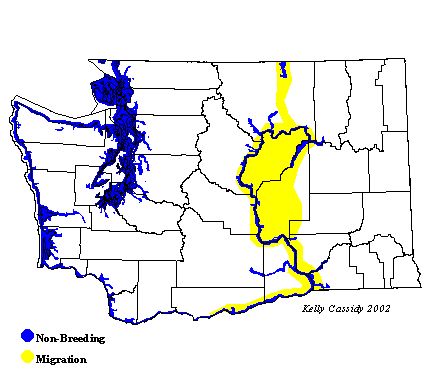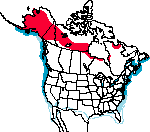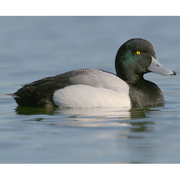Greater Scaup
General Description
The male Greater Scaup has white flanks, a black rump and breast, and barred gray back. He has a green-black iridescent head and light gray-blue bill. The adult in its second year has a yellow eye. The male in non-breeding plumage has a black head and breast, brown body, and black rump. The female is brownish overall, also with a yellow eye after the age of two. The female also has a white semi-circle at the base of the beak. The Greater and Lesser Scaup can be difficult to distinguish in the field. The Greater Scaup averages about 10% longer and 20% heavier than the Lesser Scaup. The Lesser Scaup has a peaked, angular head that the Greater Scaup lacks. The Greater Scaup has a larger bill with a more pronounced nail (tip of the bill) than the Lesser Scaup. Seen in flight, the white on the wings of the Greater Scaup extends into the primaries, where it is gray on the Lesser Scaup. Habitat, range, and season may help differentiate between the two species, as well as using a field guide and working with experienced observers.
Habitat
The Greater Scaup is the more northerly of the two species of North American Scaup. In the summer, they breed on marshy, lowland tundra at the northern limits of the boreal forest. In winter, they gather in coastal bays, lagoons, and estuaries, with some wintering on inland lakes. While the Greater Scaup does overlap with the Lesser Scaup in winter, it tends to frequent more open, exposed areas.
Behavior
Outside of the breeding season, Greater Scaup form large flocks or rafts, numbering in the thousands. In tidal waters, they tend to face up-current. While individuals may drift downstream, birds from the back of the flock fly to the front, maintaining the raft in the same position. A diver, the Greater Scaup catches its food under water, but eats it on the surface. Occasionally scaups forage at or near the water's surface as well.
Diet
Mollusks and plant material are both important components of the Greater Scaup's diet. In the summer, aquatic insects and crustaceans are also eaten.
Nesting
While Greater Scaup may nest at one year of age, they are more likely to begin breeding at the age of two. Pair formation begins in late winter or early spring on the wintering grounds and during migration back to the breeding grounds. The pair bond lasts until the female begins to incubate, and then the male leaves. Nests are located close to the water on an island, shoreline, or floating mat of vegetation, often close together in loose colonies. The female makes a shallow depression lined with grass. During incubation, the female adds down to the nest. Incubation of the 6 to 9 eggs lasts for 23 to 28 days. Soon after they hatch, the female leads the young to the water. Multiple broods may form small crèches and be tended by one or more females. The young can swim and find their own food immediately, but can't fly until about 40 to 45 days old.
Migration Status
Greater Scaups wintering in Washington breed in Alaska, although not all Alaskan scaups migrate down the West Coast. Some migrate along the Mississippi and Eastern flyways.
Conservation Status
Greater Scaups appear to be abundant, although confusion between the Greater and Lesser Scaup makes it difficult to track changes in population. Estimates of scaup populations across North America put the Greater Scaup at about 11% of the combined continental scaup population, although the majority of the scaup wintering in Puget Sound are Greater Scaups. Their heavy concentration in coastal bays in winter makes the population vulnerable to oil spills and other pollution.
When and Where to Find in Washington
Greater Scaups are found during migration and winter in bodies of water in all lowland areas of Washington, although they are more common in salt water than they are in fresh water habitats. West of the Cascades, Greater Scaups start arriving in August and become common from September to mid-May, when most depart for northern breeding areas. Small numbers regularly summer in sewage ponds in western Washington. East of the Cascades they can be found from mid-October until mid-April before heading north.
 Abundance
Abundance
| Ecoregion | Jan | Feb | Mar | Apr | May | Jun | Jul | Aug | Sep | Oct | Nov | Dec |
|---|---|---|---|---|---|---|---|---|---|---|---|---|
| Oceanic | ||||||||||||
| Pacific Northwest Coast | C | C | C | C | F | R | R | U | F | C | C | C |
| Puget Trough | C | C | C | F | F | U | F | C | C | |||
| North Cascades | R | R | R | R | R | R | R | R | R | R | ||
| West Cascades | F | F | F | U | R | R | R | R | U | F | F | F |
| East Cascades | U | U | U | U | R | R | U | U | U | |||
| Okanogan | U | U | U | F | U | R | R | R | U | F | U | U |
| Canadian Rockies | U | U | F | F | F | U | U | |||||
| Blue Mountains | ||||||||||||
| Columbia Plateau | U | U | U | U | R | R | U | U | U |
Washington Range Map

North American Range Map


Family Members
 Fulvous Whistling-DuckDendrocygna bicolor
Fulvous Whistling-DuckDendrocygna bicolor Taiga Bean-GooseAnser fabalis
Taiga Bean-GooseAnser fabalis Greater White-fronted GooseAnser albifrons
Greater White-fronted GooseAnser albifrons Emperor GooseChen canagica
Emperor GooseChen canagica Snow GooseChen caerulescens
Snow GooseChen caerulescens Ross's GooseChen rossii
Ross's GooseChen rossii BrantBranta bernicla
BrantBranta bernicla Cackling GooseBranta hutchinsii
Cackling GooseBranta hutchinsii Canada GooseBranta canadensis
Canada GooseBranta canadensis Mute SwanCygnus olor
Mute SwanCygnus olor Trumpeter SwanCygnus buccinator
Trumpeter SwanCygnus buccinator Tundra SwanCygnus columbianus
Tundra SwanCygnus columbianus Wood DuckAix sponsa
Wood DuckAix sponsa GadwallAnas strepera
GadwallAnas strepera Falcated DuckAnas falcata
Falcated DuckAnas falcata Eurasian WigeonAnas penelope
Eurasian WigeonAnas penelope American WigeonAnas americana
American WigeonAnas americana American Black DuckAnas rubripes
American Black DuckAnas rubripes MallardAnas platyrhynchos
MallardAnas platyrhynchos Blue-winged TealAnas discors
Blue-winged TealAnas discors Cinnamon TealAnas cyanoptera
Cinnamon TealAnas cyanoptera Northern ShovelerAnas clypeata
Northern ShovelerAnas clypeata Northern PintailAnas acuta
Northern PintailAnas acuta GarganeyAnas querquedula
GarganeyAnas querquedula Baikal TealAnas formosa
Baikal TealAnas formosa Green-winged TealAnas crecca
Green-winged TealAnas crecca CanvasbackAythya valisineria
CanvasbackAythya valisineria RedheadAythya americana
RedheadAythya americana Ring-necked DuckAythya collaris
Ring-necked DuckAythya collaris Tufted DuckAythya fuligula
Tufted DuckAythya fuligula Greater ScaupAythya marila
Greater ScaupAythya marila Lesser ScaupAythya affinis
Lesser ScaupAythya affinis Steller's EiderPolysticta stelleri
Steller's EiderPolysticta stelleri King EiderSomateria spectabilis
King EiderSomateria spectabilis Common EiderSomateria mollissima
Common EiderSomateria mollissima Harlequin DuckHistrionicus histrionicus
Harlequin DuckHistrionicus histrionicus Surf ScoterMelanitta perspicillata
Surf ScoterMelanitta perspicillata White-winged ScoterMelanitta fusca
White-winged ScoterMelanitta fusca Black ScoterMelanitta nigra
Black ScoterMelanitta nigra Long-tailed DuckClangula hyemalis
Long-tailed DuckClangula hyemalis BuffleheadBucephala albeola
BuffleheadBucephala albeola Common GoldeneyeBucephala clangula
Common GoldeneyeBucephala clangula Barrow's GoldeneyeBucephala islandica
Barrow's GoldeneyeBucephala islandica SmewMergellus albellus
SmewMergellus albellus Hooded MerganserLophodytes cucullatus
Hooded MerganserLophodytes cucullatus Common MerganserMergus merganser
Common MerganserMergus merganser Red-breasted MerganserMergus serrator
Red-breasted MerganserMergus serrator Ruddy DuckOxyura jamaicensis
Ruddy DuckOxyura jamaicensis

